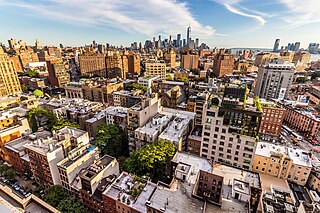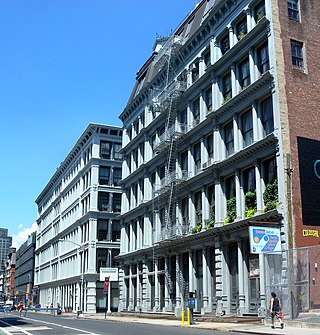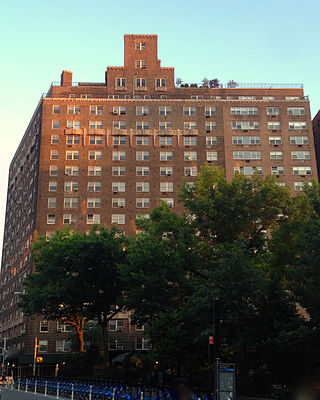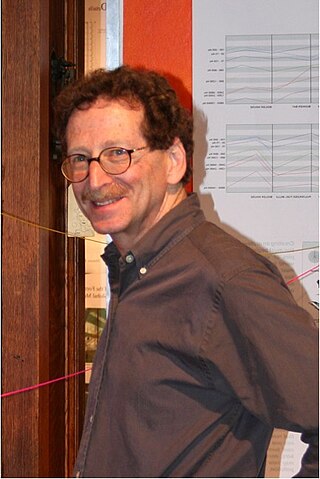Related Research Articles

Greenwich Village, or simply the Village, is a neighborhood on the west side of Lower Manhattan in New York City, bounded by 14th Street to the north, Broadway to the east, Houston Street to the south, and the Hudson River to the west. Greenwich Village also contains several subsections, including the West Village west of Seventh Avenue and the Meatpacking District in the northwest corner of Greenwich Village.

SoHo, short for "South of Houston Street", is a neighborhood in Lower Manhattan, New York City. Since the 1970s, the neighborhood has been the location of many artists' lofts and art galleries, and has also been known for its variety of shops ranging from trendy upscale boutiques to national and international chain store locations. The area's history is an archetypal example of inner-city regeneration and gentrification, encompassing socioeconomic, cultural, political, and architectural developments.

Alphabet City is a neighborhood located within the East Village in the New York City borough of Manhattan. Its name comes from Avenues A, B, C, and D, the only avenues in Manhattan to have single-letter names. It is bounded by Houston Street to the south and 14th Street to the north, and extends roughly from Avenue A to the East River. Some famous landmarks include Tompkins Square Park, the Nuyorican Poets Cafe and the Charlie Parker Residence.

The East Village is a neighborhood on the East Side of Lower Manhattan in New York City, United States. It is roughly defined as the area east of the Bowery and Third Avenue, between 14th Street on the north and Houston Street on the south. The East Village contains three subsections: Alphabet City, in reference to the single-letter-named avenues that are located to the east of First Avenue; Little Ukraine, near Second Avenue and 6th and 7th Streets; and the Bowery, located around the street of the same name.

The Jefferson Market Branch of the New York Public Library, once known as the Jefferson Market Courthouse, is a National Historic Landmark located at 425 Avenue of the Americas, on the southwest corner of West 10th Street, in Greenwich Village, Manhattan, New York City, on a triangular plot formed by Greenwich Avenue and West 10th Street. It was originally built as the Third Judicial District Courthouse from 1874 to 1877, and was designed by architect Frederick Clarke Withers of the firm of Vaux and Withers.

Anthology Film Archives is an international center for the preservation, study, and exhibition of film and video, with a particular focus on independent, experimental, and avant-garde cinema. The film archive and theater is located at 32 Second Avenue on the southeast corner of East 2nd Street, in a New York City historic district in the East Village neighborhood of Manhattan.

The West Village is a neighborhood in the western section of the larger Greenwich Village neighborhood of Lower Manhattan, New York City. The West Village is bounded by the Hudson River to the west and 14th Street to the north. The eastern boundary is variously cited as Greenwich Avenue, Seventh Avenue, or Sixth Avenue, while the southern boundary is either Houston Street or Christopher Street.

Webster Hall is a nightclub and concert venue located at 125 East 11th Street, between Third and Fourth Avenues, near Astor Place, in the East Village of Manhattan, New York City. It is one of New York City's most historically significant theater and event halls, having hosted social events of all types since the club's construction in 1886 as a "hall for hire". Its current incarnation was opened in 1992 by the Ballinger brothers, with a capacity of 1,400, providing its traditional role as well as for corporate events, and for a recording studio. A scholarly account of Webster Hall and its place in the wider history of rock music in Lower Manhattan was published in 2020.

Westbeth Artists Housing is a nonprofit housing and commercial complex dedicated to providing affordable living and working space for artists and arts organizations in New York City. The complex comprises the full city block bounded by West, Bethune, Washington and Bank Streets in the West Village neighborhood of Manhattan, New York City; the complex is named for the streets West and Bethune.

St. Mark's Church in-the-Bowery is a parish of the Episcopal Church at 131 East 10th Street(at the intersection of Stuyvesant Street and Second Avenue) in the East Village neighborhood of Manhattan in New York City. The property has been the site of continuous Christian worship since the mid-17th century, making it New York City's oldest site of continuous religious practice. The structure is the second-oldest church building in Manhattan.

Andrew Scott Dolkart is a professor of Historic Preservation at the Columbia University Graduate School of Architecture, Planning and Preservation (GSAPP) and served as the Director of the school's Historic Preservation Program from 2008 to 2016.

Meserich Synagogue, Meserich Shul or Meseritz Shul, also known as Edes Israel Anshei Mesrich, Edath Lei'Isroel Ansche Meseritz or Adas Yisroel Anshe Mezeritz, is an Orthodox Jewish synagogue located at 415 East 6th Street, in the East Village of Manhattan, New York City, New York, United States.

The New York Landmarks Conservancy is a non-profit organization "dedicated to preserving, revitalizing, and reusing" historic structures in New York state. It provides technical and financial skills to owners of historic properties. In the half century since its 1973 founding, the conservancy has provided more than $60 million in grants and loans.

Village Preservation is a nonprofit organization that advocates for the architectural preservation and cultural preservation in several neighborhoods of Lower Manhattan in New York City. Founded in 1980, it has advocated for New York City designated landmark status for a variety of sites like the Stonewall Inn and Webster Hall. The organization and its Executive Director, Andrew Berman, have been described as influential in New York real estate, while some of its activities to prevent development and to support restrictive zoning have attracted criticism.

The South Village is a largely residential area that is part of the larger Greenwich Village in Lower Manhattan, New York City, directly below Washington Square Park. Known for its immigrant heritage and bohemian history, the architecture of the South Village is primarily tenement-style apartment buildings, indicative of the area's history as an enclave for Italian-American immigrants and working-class residents of New York.

The German Evangelical Lutheran Church of St. Mark is an historic former church and current synagogue building located at 323 East 6th Street between First and Second Avenues in the East Village neighborhood of Manhattan, in New York City, New York, United States.

The East Village/Lower East Side Historic District in Lower Manhattan, New York City was created by the New York City Landmarks Preservation Commission on October 9, 2012. It encompasses 330 buildings, mostly in the East Village neighborhood, primarily along Second Avenue between East 2nd and 6th Streets, and along the side streets. Some of the buildings are located in a second area between First Avenue and Avenue A along East 6th and 7th Streets. The district is based on the one which had been proposed by the Greenwich Village Society for Historic Preservation, with only minor changes, and is the result of a two-year effort to protect the area.
Andrew Berman is an architectural and cultural heritage preservationist in New York City. He is known for being an opponent of new housing construction in New York City.
CHARAS/El Bohio Community Center was a neighborhood organization and squatted community center in New York's East Village between 1979 and 2001.
James and Karla Murray are American photographers. The husband and wife duo have photographed storefronts of small businesses in New York City and elsewhere. They have also constructed a sculptural installation based on their photographic work.
References
- ↑ Nir, Sarah Maslin (December 7, 2009). "The Lower East Side's Changing Fortunes". The New York Times.
- ↑ "Many projects but one goal: Saving L.E.S. history". The Villager. January 12, 2009.[ permanent dead link ]
- ↑ Citizen's Committee for New York City award Archived 2013-01-23 at the Wayback Machine
- ↑ Greenwich Village Society for Historic Preservation award